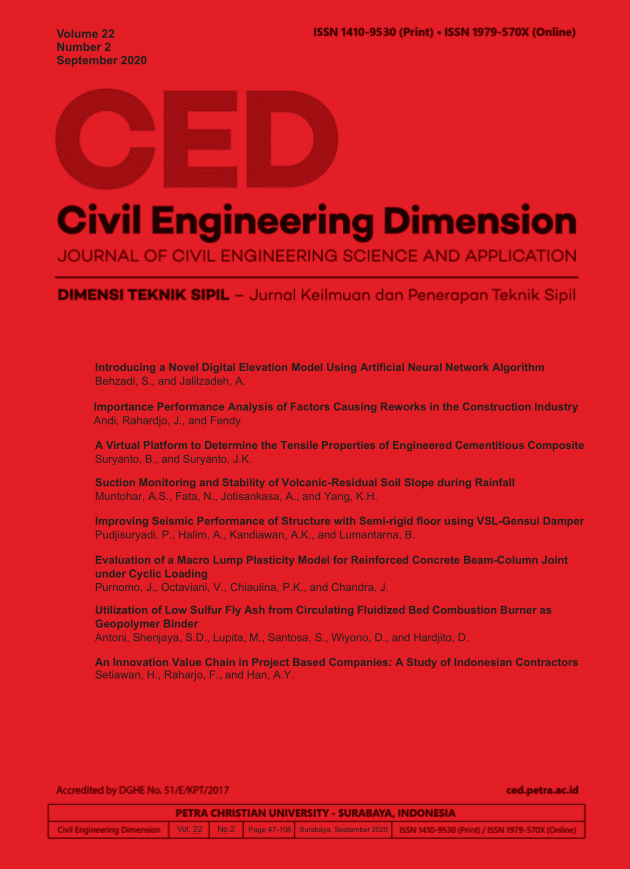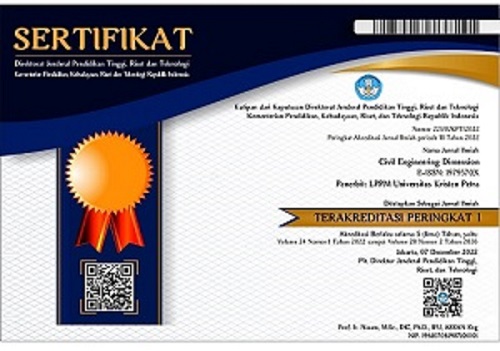Suction Monitoring and Stability of Volcanic-Residual Soil Slope during Rainfall
 :
:
https://doi.org/10.9744/ced.22.2.67-73
Keywords:
Suction, rainfall, volcanic soil, slope stability, unsaturated soil.Abstract
Some slopes in Yogyakarta, Indonesia, were covered by volcanic soil of the quaternary deposit of Merapi volcano. Typically, the soil layers of the slope consist of fine sand or silty sand. During the wet season (November – February), the slope is prone to instability due to rainfall infiltration. This paper presents the field suction monitoring of silty-sand slope. A 2.57 m high slope at Universitas Muhammadiyah Yogyakarta campus was instrumented with a mini tensiometer, moisture probe, and rain gauge to study the effect of suction on the slope stability during rainfall in wet season. The investigation shows that the rainfall decreases the suction and increase the moisture of soil. This situation leads to slope instability. The factor of safety fluctuates corresponding to the rainfall intensity. The lowest factor of safety was attained on 30 December, in which the rainfall intensity is the highest, i.e. 48 mm/day.References
Tohari, A., Sarah, D., and Daryono, M. R., Hydro-logical Condition Leading to Landslide Initiation, Media Teknik Sipil, 8(2), 2008, pp. 67-76.
Lim, T. T., Rahardjo, H., Chang, M. F., and Fred-lund, D. G., Effect 0f Rainfall on Matric Suctions in a Residual Soil Slope, Canadian Geotechnical Journal, 33(4), 1996, pp. 618-628.
Tu, X. B., Kwong, A. K. L., Dai, F. C., Tham, L. G., and Min, H., Field Monitoring of Rainfall Infiltration in a Loess Slope and Analysis of Failure Mechanism of Rainfall-Induced Lands¬lides, Engineering Geology, 105, 2009, pp. 134–150.
Kristo, C., Rahardjo, H., and Satyanaga, A., Effect of Variations in Rainfall Intensity on Slope Stability in Singapore, International Soil and Water Conservation Research, 5(4), 2017, pp. 258-264.
Rahardjo, H., Nio, A.S., Harnas, F.R., and Leong, E. C., Comprehensive Instrumentation for Real Time Monitoring of Flux Boundary Conditions in Slope, Procedia Earth and Planetary Science, 9, 2014, pp. 23-43.
Afeni, T. B. and Cawood, F. T., Slope Monitoring using Total Station: What Are the Challenges and How Should these Be Mitigated?, South African Journal of Geomatics, 2(1), 2013, pp. 41-53.
Lienhart, W., Geotechnical Monitoring using Total Stations and Laser Scanners: Critical As¬pects and Solutions, Journal of Civil Structural Health Monitoring, 7(3), 2017, pp. 315-324.
Rahardjo, H., Satyanaga, A., and Leong, E.-C., Effects of Flux Boundary Conditions on Pore-Water Pressure Distribution in Slope, Engi¬neering Geology, 165, 2013, pp. 133-142.
Jotisankasa, A. and Mairaing, W., Suction-Moni¬tored Direct Shear Testing of Residual Soils from Landslide-Prone Areas, Journal of Geotechnical and Geoenvironmental Engineering, 136(3), 2010, pp. 533–537.
Muntohar, A.S., Influence of the Soil-Water Retention Curve Models on the Stability of Residuals Soils Slope, in Pertemuan Ilmiah Tahunan ke-19 Himpunan Ahli Teknik Tanah Indonesia, Jakarta, 24-25 November 2015 2015: Himpunan Ahli Teknik Tanah Indonesia, pp. 237-244.
Muntohar, A. S., Ikhsan, J., and Mukhlisin, M., Studi Dampak Perubahan Iklim Terhadap Longsoran Lereng (Research Report), Unversitas Muhammadiyah Yogyakarta, 2016.
ASTM D2487, Standard Practice for Classi¬fication of Soils for Engineering Purposes (Unified Soil Classification System), ASTM International, 2006.
van Genuchten, M.T., A Closed-Form Equation for Predicting the Hydraulic Conductivity of Unsaturated Soils, Soil Science Society of Ame¬rican Journal, 44, 1980, pp. 892-898.
Mualem, Y., A New Model for Predicting the Hydraulic Conductivity of Unsaturated Porous Media, Water Resources Research, 12(3), 1976, pp. 513-522.
GeoStudio, Stability Modeling with SLOPE/W Calgary, Alberta, Canada: Geo-Slope Internatio¬nal Ltd., 2004.
GeoStudio, Seepage Modeling with SEEP/W Calgary, Alberta, Canada Geo-Slope Internatio¬nal Ltd., 2004.
Rahardjo, H., Ong, T.H., Rezaur, R.B., and Leong, E.C., Factors Controlling Instability of Homogeneous Soil Slopes under Rainfall, Jour¬nal of Geotechnical and Geoenvironmental Engineering, 133(12), 2007, pp. 1532-1543.
Zhan, T.L.T., Ng, C.W.W., and Fredlund, D.G., Field Study of Rainfall Infiltration into a Grassed Unsaturated Expansive Soil Slope, Canadian Geotechnical Journal, 44(4), 2007, pp. 392-408.
Muntohar, A.S., Ikhsan, J., and Liao, H.J., Influence of Rainfall Patterns on the Instability of Slopes, Civil Engineering Dimension, 15(2), 2013, pp. 120-128.
Yildiz, A., Graf, F., Rickli, C., and Springman, S. M., Assessment of Plant-Induced Suction and Its Effects on the Shear Strength of Rooted Soils, Proceedings of the Institution of Civil Engineers - Geotechnical Engineering, 172(6), 2019, pp. 507-519.
McDougall, J.R. and Pyrah, I.C., Simulating Transient Infiltration in Unsaturated Soils, Canadian Geotechnical Journal, 35(6), 1998, pp. 1093-1100.
Lu, N., Kaya, B.S., and Godt, J.W., Direction of Unsaturated Flow in A Homogeneous and Iso¬tropic Hillslope, Water Resources Research, 47(2), 2011.
Chatra, A.S., Dodagoudar, G.R., and Maji, V.B., Numerical Modelling of Rainfall Effects on The Stability of Soil Slopes, International Journal of Geotechnical Engineering, 2017, pp. 1-13.
Li, A.G., Yue, Z.Q., Tham, L.G., Lee, C.F., and Law, K.T., Field-Monitored Variations of Soil Moisture and Matric Suction in a Saprolite Slope, Canadian Geotechnical Journal, 42(1), 2005, pp. 13-26.
Downloads
Published
How to Cite
Issue
Section
License
Authors who publish with this journal agree to the following terms:- Authors retain the copyright and publishing right, and grant the journal right of first publication with the work simultaneously licensed under a Creative Commons Attribution License that allows others to share the work with an acknowledgement of the work's authorship and initial publication in this journal.
- Authors are able to enter into separate, additional contractual arrangements for the non-exclusive distribution of the journal's published version of the work (e.g., post it to an institutional repository or publish it in a book), with an acknowledgement of its initial publication in this journal.
- Authors are permitted and encouraged to post their work online (e.g., in institutional repositories or on their website) followingthe publication of the article, as it can lead to productive exchanges, as well as earlier and greater citation of published work (See The Effect of Open Access).

















